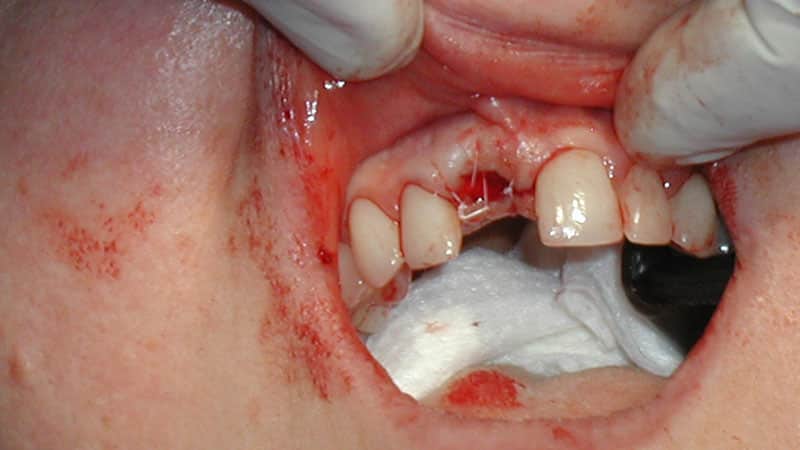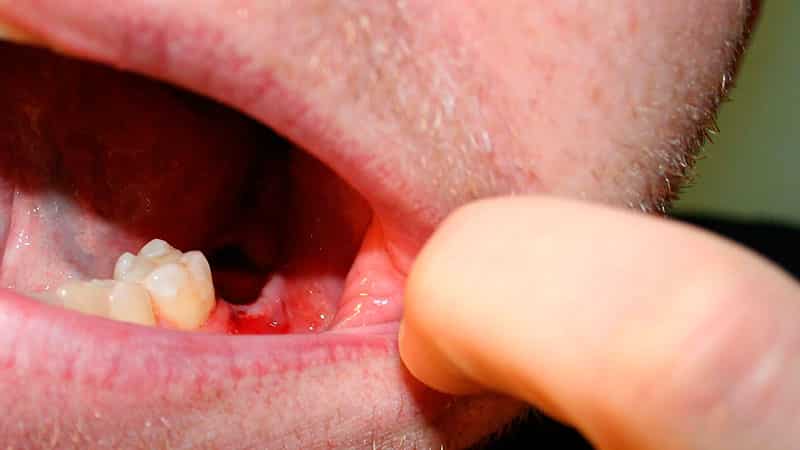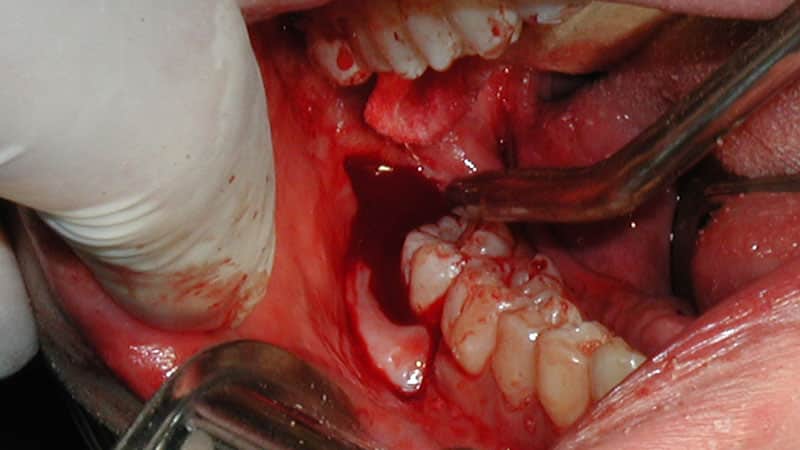Surgery to remove a tooth is a complex operation that removes the tooth from the gums, where it is held in place by tissues supplied with blood. During surgery, the tissues holding the tooth are torn and bleeding occurs. Stopping blood loss is not easy, sometimes the process takes time. So, what to do if a tooth is pulled out, blood is flowing, how to stop it?
Bleeding gums after tooth extraction
You should know that profuse bleeding from the hole, which appears as a result of pulling out a tooth, is a common consequence. But this process should be controlled not only by the surgeon, but also by the patient. Many people often do not even think about how to stop the bleeding, because after the operation, the dentist performs all the necessary procedures, thanks to which the wound stops bleeding.
But occasionally, after dental intervention, the hole bleeds for a very long time. Such a phenomenon very often contributes to panic emotions and fears that the person will eventually lose a lot of blood and die.
However, almost no one died from blood loss after pulling out a tooth. But the constant loss of blood can cause a malfunction in the functioning of the body. To prevent this from happening, it is desirable to know:
- underlying factors that contribute to persistent bleeding;
- what is the rate and timing of bleeding;
- how to stop bleeding on your own to prevent the development of complications.
Causes of bleeding
When the tissues near the tooth are damaged, there is always bleeding. Under normal circumstances, after 2-3 hours, a clot forms in the wound, which performs a protective function, so that infections living in the oral cavity do not penetrate into the hole. If the natural barrier has not formed, and the release of blood has not decreased, this indicates primary bleeding. And when the wound first stops bleeding, but after the discharge they appear again, this phenomenon is called secondary bleeding.
Often, if a wisdom tooth is removed, the blood does not stop due to the influence of a local factor - due to surgical intervention, during which soft tissues with a developed vascular system were injured, or due to damage to the alveolar bone.

How to stop bleeding after tooth extraction?
If large arterial branches were affected, then the discharge will ooze from the deepening of the wound. Abundant blood flow is often associated with acute inflammatory processes occurring in the affected teeth located next to the hole. This happens because during inflammation, the vessels dilate, as a result of which the blood does not stop. When the effect of the anesthetic injection stops, sometimes the vessels may dilate, but in this case, spotting will appear not after the amputation, but after a while (20 minutes - 3 hours).
There are also common factors that contribute to a prolonged primary and abundant secondary bleeding:
- vascular injury or poor blood clotting due to various ailments;
- arterial hypertension;
- treatment with heparin or anticoagulants with indirect action.
If the abundant release of blood clots after the removal of the incisor, molar, canine is not stopped, then this condition can cause a general deterioration in health, which is accompanied by such signs:
- general malaise;
- dizziness;
- rapid pulse;
- low blood pressure (arterial);
- pallor of the skin.
Despite the fact that deaths due to a bleeding wound in the oral cavity are extremely rare, as a preventive measure, all medical recommendations must be followed so that blood loss stops and the body functions normally.
What time of bleeding from the hole is considered normal
How to stop bleeding after tooth extraction? Bleeding from the gums is stopped through the use of various methodology, in which the doctor relies on the specifics of the operation and the individual characteristics of the patient. According to the norm, the process of clot formation begins in 10–35 minutes. after operation. Therefore, if the profuse discharge of blood does not stop after half an hour, or the discharge begins after some time (already at home), then this indicates the presence of some kind of pathology.

How to stop bleeding gums after tooth extraction
Very often, patients mistakenly take the discharge of an ichor from the wound for bleeding. The ichor may ooze for a couple of hours after the operation. It is an almost colorless substance, sometimes with a yellowish tint, with blood impurities. Its appearance is quite natural, so you should not take it for a complication. Sometimes the separation of the ichor does not stop until 12 o'clock, but the intensity of the secretions is different. It is pointless to worry under such circumstances, because. this phenomenon is considered normal.
How to stop the bleeding yourself: three effective methods
If the hole left after the tooth is pulled out bleeds for a long time, and a clot does not form, then the patient can resort to hemostasis on his own. How to stop bleeding after tooth extraction? Bleeding does not stop - use effective and simple home methods.

How much blood flows after the removal of a wisdom tooth
There are three main methods, thanks to which you can cope with abundant blood discharge yourself:
- put a gauze swab in your mouth and hold it between your teeth for half an hour. You can form a tampon yourself, for this it is enough to buy a sterile bandage in a pharmacy. The effectiveness of this method lies not in the fact that the gauze absorbs spotting, it squeezes the edges of the wound. Therefore, the bandage should be squeezed as tightly as possible;
- if the above method does not bring the desired result, then a little hydrogen peroxide (3%) should be applied to the gauze napkin. In this case, the hemostatic effect will be achieved, because. peroxide promotes blood clotting. However, you need to keep such a tampon for a short time - a couple of minutes;
- also on the wound, you need to place a hemostatic sponge purchased at a pharmacy, and then put it on the hole and clench your teeth tightly. But it is not easy to implement the plan, because. for maximum effect, the sponge should not be located on the surface of the hole, but in its middle. In general, the hemostatic sponge is intended for professional use, however, it can be used for self-treatment purposes. But the downside is that its application is difficult from a technical point of view.
Naturally, it is useful for every person to know how to deal with bleeding in the mouth at home. But even the use of these methods does not always bring the expected result, because sometimes the causes of abundant and prolonged discharge from the hole can lie in the intake of special medications or in the presence of serious ailments.
In such cases, none of the above methods will help, and time will be lost. For these reasons, if the bleeding has not stopped after two hours, medical attention should be sought.
Hemostasis after pulling out the figure eight
The removal of wisdom teeth is a special, difficult process, its complexity lies in the features of the distant location of the teeth. They are placed in an area where there is an abundant blood supply. Therefore, blood loss due to pulling out the figure eight is strong and prolonged.
How much blood flows after the removal of a wisdom tooth? The gum bleeds after the removal of the figure eight as well as in other cases (15-40 minutes). It is during this period of time that a clot should appear. If during the surgical intervention the gums were cut or the roots were cut out, and the wound was sutured, the bloody fluid should in any case cease to be released in a maximum of 30 minutes.
It should be noted that the procedure for removing the figure eight is considered a surgical intervention of particular complexity, therefore the cost of such services is always higher than standard dental surgical methods. Eights also create difficulties in that they are often crooked or their roots are tangled with the roots of the nearest teeth.





